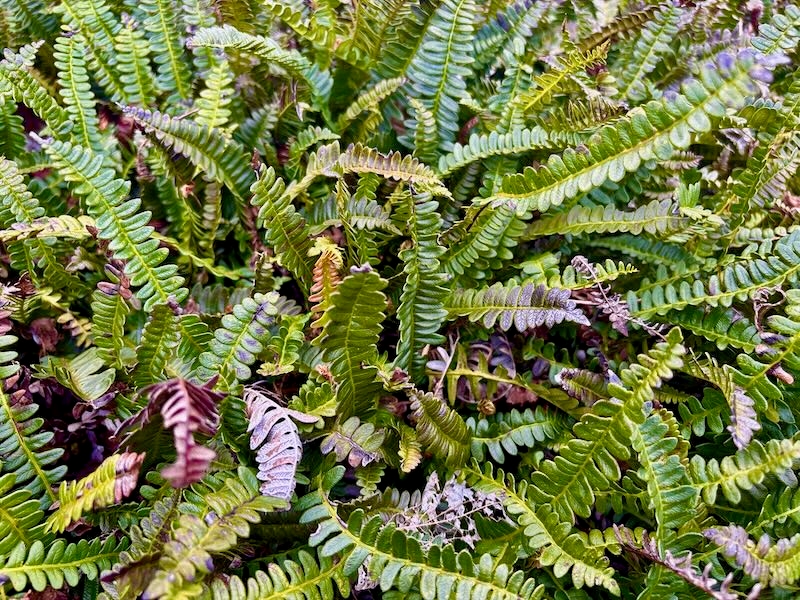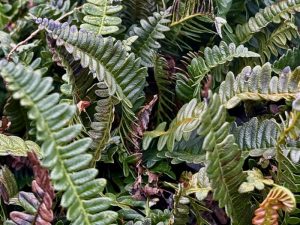Austroblechnum penna-marina: A Hardy Groundcover Fern for Cool, Damp Gardens
Austroblechnum penna-marina, also known by its synonym Blechnum penna-marina, is a resilient evergreen fern belonging to the family Blechnaceae. Commonly referred to as Alpine Water Fern, Antarctic Hard-fern, or little hard fern, this species forms a dense mat of spreading fronds that provide attractive, year-round groundcover. Its young fronds often emerge a reddish-bronze before maturing to a glossy green, offering subtle seasonal color shifts.
Background and Habitat
Austroblechnum penna-marina is widely distributed across the Southern Hemisphere, naturally occurring in New Zealand, Australia, and South America, including subantarctic regions like Marion Island. It thrives in diverse habitats, from coastal forests to alpine herb fields, creek beds, river terraces, and rocky slopes, at elevations ranging from sea level up to 1,900 meters (6,200 feet). This adaptability makes it an ideal choice for gardeners in cooler climates who want a reliable, low-growing fern.
Botanical Description
This fern features wiry rhizomes that spread slowly to form dense, creeping mats. Its fronds are distinctly dimorphic: the sterile fronds are prostrate or semi-erect and grow up to 15–40 cm (6–16 inches) in length, while the fertile fronds are longer and held upright, often reaching double the size. Sterile fronds have yellow-brown stipes, while fertile fronds carry purplish-black stipes, adding visual interest. The fronds are simply pinnate, with 12–44 pairs of triangular or oblong pinnae on sterile fronds and 10–36 pairs of narrower pinnae on fertile fronds.
Growing Conditions for Austroblechnum penna-marina
Light: Prefers partial to full shade, though it can tolerate full sun in cooler climates with adequate moisture. In warmer areas, dappled shade is ideal to prevent frond scorching.
Soil: Thrives in consistently moist, well-drained, acidic soils (pH 5.5–6.5). Amend heavy clay with organic matter to improve aeration and drainage.
Watering: Requires consistently moist soil, especially during dry spells and in its first year of establishment. Water deeply and directly at the base to ensure the rhizomes stay hydrated.
Fertilizing: Apply a diluted fern or seaweed-based fertilizer during the growing season (spring through early autumn). Avoid heavy feeding, as this fern performs well in nutrient-poor conditions.
Temperature: Best suited for cool, damp environments, with ideal productivity at temperatures between 6–11°C (43–52°F). Hardy in USDA zones 7–9.
Maintenance and Care
Austroblechnum penna-marina is a low-maintenance plant, perfect for shaded gardens, woodland settings, or as underplanting for larger shrubs and trees. Remove old or damaged fronds to keep the clumps looking fresh. Apply a light mulch to conserve soil moisture and suppress weeds. In time, divide large clumps in spring to rejuvenate growth and propagate new plants.
Propagation of Austroblechnum penna-marina
This fern can be propagated by division in spring or by sowing spores on moist compost. Division is the easiest and fastest method, allowing gardeners to expand coverage or share plants.
Pests and Diseases
This species is highly resistant to common pests such as deer, rabbits, slugs, and snails. No serious diseases are known to affect it, though frond yellowing may indicate underwatering, poor drainage, or nutrient imbalance.
Uses in the Garden
Austroblechnum penna-marina is prized for its ability to form lush, low-growing mats in shaded or semi-shaded spaces. It is ideal for rock gardens, woodland borders, damp creek edges, or as a living mulch beneath trees. Its evergreen habit ensures year-round interest, and its reddish emerging fronds add a subtle seasonal highlight.



